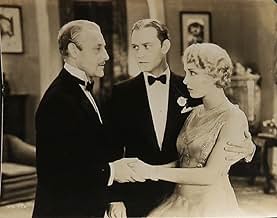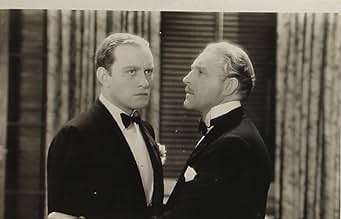En una mansión británica cerca de Calcuta, un inspector y una falsa medium intentan resolver dos asesinatos de los que una mujer es sospechosa.En una mansión británica cerca de Calcuta, un inspector y una falsa medium intentan resolver dos asesinatos de los que una mujer es sospechosa.En una mansión británica cerca de Calcuta, un inspector y una falsa medium intentan resolver dos asesinatos de los que una mujer es sospechosa.
- Dirección
- Guionistas
- Elenco
- Premios
- 1 premio ganado en total
Charles Quatermaine
- Dr. Philip Mason
- (as Charles Quartermaine)
- Dirección
- Guionistas
- Todo el elenco y el equipo
- Producción, taquilla y más en IMDbPro
Opiniones destacadas
Recently saw this enjoyable little curio on TCM. Adding to the comments of others on the matter of style, I was surprised to notice several examples of short graceful tracking shots forward or back, just to break up the sense of staginess. (The mansion has very smooth floors!) So it's not that the camera is absolutely static. But Browning avoids close-ups for the most part. What was odd is the editing at certain times, which seems way off. There's one bizarre moment when the actors are clearly gathered in preparation for when the director calls "Action," and then after a few seconds, they abruptly begin speaking to each other in mid-sentence. (I'd like to see someone do a whole movie like that!) There's an equally strange edit when Margaret Wycherley walks out of the frame to confront Bela Lugosi (a few steps away), and then we cut to Lugosi sitting in his chair waiting an awfully long time beside dead space for her to walk into frame. I wonder what that was about?
This isn't a typical Tod Browning film. It's more or less a very basic filming of a stage play (I gather; I don't know that for sure, but it feels very stagey) about a group of rich people who hire a medium to find out who killed their friend (and, to some of the group, an enemy). When they go into their seance, right as the name of the killer is about to be spoken, one of the men in the circle, the one who was succeeding at questioning the medium, is stabbed in the back. They then call a detective (Bela Lugosi) who grills them, trying to discover who murdered both of these men. I don't generally like whodunits, especially the Clue variety, where a detective gathers all the suspects in a room and attempts to root out the real killer, but The Thirteenth Chair is exceptionally written. The characters, and there are many, are quite well developed. The climactic scene, while asking that we suspend our disbelief, is truly suspenseful. See this gem if you ever get the chance. 9/10.
This seems to have been the first major film role film for Bela Lugosi. He dominates the film entirely, with tremendous confidence and panache. Two years later, he and the same director, Tod Browning, would make their famous horror classic 'Dracula' (1931) together. This film is based on a stage play by Bayard Veiller, whose wife, Margaret Wycherley, played the medium both on stage and in the film, to great effect. Since talkies only commenced the year before, this 1929 film does very well in the sound department. What is really terrible about it is the editing, some of the worst any feature film ever had: a woman gets up from her chair and exits frame and we wait for some time, then we cut to the next frame and wait an endless age for her to enter that frame. Really appalling! Tod Browning either had no control over this process or had not learned to direct properly yet. Despite the slow pace and creaky nature of the production, the film nevertheless manages to be intriguing in its excellently complex mystery plot. It is one of those 'people in a room in the dark' films: whodunnit? There are plenty of surprises. The story is ostensibly set in Calcutta, under the Empire, although shot entirely in a studio. It is an interesting study of how British Empire types behaved in the 1920s, hence of considerable social history interest as a 'document'. (They don't come out of it well, being so arch, false, and over-mannered that one does not regret their passing.) The main action centres round a seance and the activities of a medium, in connection with trying to solve the murder of someone who was 'an out and out rotter'. Despite its shortcomings, this film is still entertaining and worth watching.
In British India, a séance in Calcutta leaves a dead man sitting in THE THIRTEENTH CHAIR...
Under the able direction of Tod Browning, this antique talkie weaves a taut tale of murder & suspense. The oppressive atmosphere & limited use of sets creates a claustrophobic sense of eerie unreality. The excellent utilization of sound during the sequences of almost total screen blackout demonstrate the director's understanding of the potentialities of the new medium.
Conrad Nagel & Leila Hyams receive top billing, but they have little to do beyond looking frightened or concerned. This they accomplish quite well.
The film is dominated by two fascinating performances. Bela Lugosi makes a rather bizarre police inspector, his mesmeric eyes, claw-like hands & compelling voice giving an early demonstration of the qualities which would make him one of the screen's top monsters (Lugosi & Browning would have to wait two more years for the huge success of their next collaboration, DRACULA). Elderly Margaret Wycherly, as a wily Irish medium, is a delight and easily steals scene after scene. It is she who comes up with the plan to ultimately unmask the killer.
Under the able direction of Tod Browning, this antique talkie weaves a taut tale of murder & suspense. The oppressive atmosphere & limited use of sets creates a claustrophobic sense of eerie unreality. The excellent utilization of sound during the sequences of almost total screen blackout demonstrate the director's understanding of the potentialities of the new medium.
Conrad Nagel & Leila Hyams receive top billing, but they have little to do beyond looking frightened or concerned. This they accomplish quite well.
The film is dominated by two fascinating performances. Bela Lugosi makes a rather bizarre police inspector, his mesmeric eyes, claw-like hands & compelling voice giving an early demonstration of the qualities which would make him one of the screen's top monsters (Lugosi & Browning would have to wait two more years for the huge success of their next collaboration, DRACULA). Elderly Margaret Wycherly, as a wily Irish medium, is a delight and easily steals scene after scene. It is she who comes up with the plan to ultimately unmask the killer.
Given the numerous bad reviews I didn't expect to enjoy the film as much as I did. If you are an old classic movie fan, you can overlook the poor sound and visual clarity of a 1929 film, especially when the story and cast hold your attention. Leila Hyams and Margaret Wycherley are excellent, as is seeing Bella Lugosi in an earlier film role. For a movie shot in basically in two rooms, I think it was well done. I'm glad I didn't let some of the low ratings deter me from watching, it's nice to be surprised when you come across an old gem.
¿Sabías que…?
- TriviaCompleted July 16 1929, the first sound feature in which Bela Lugosi's famous Hungarian tones were heard. This was Bela Lugosi's first venture with Browning. Two years later, the director cast him in the film version of the Bram Stoker vampire tale after Chaney, Browning's first choice for the role, died. Lugosi and Browning made one other film together, Mark of the Vampire (1935), in which he played Count Mora, a knock-off of his more famous blood-sucking cousin.
- ErroresThere are several scenes where it appears the actors are waiting for their cues before they start talking, most notably when the Inspector calls them all into the room to re-create the séance.
It isn't a "goof" that the actors seem to be waiting for their cues before they start acting. Many of the earliest MGM talkies employed a technique of long, lingering inactive moments at the beginning and ending of reels, which apparently were supposed to take the place of a leader when they changed over, perhaps accommodating the Vitaphone print versions. Years ago, when these titles appeared on TV, they didn't do that, so maybe Movietone versions were more succinctly edited.
- Citas
Inspector Delzante: [Interrogating Madame La Grange, consulting his notes] Perhaps this will refresh your memory.
- Versiones alternativasMGM also released this movie in a silent version at 1628.55 m in length. The silent version of the film is considered lost as of February 2021.
- ConexionesReferenced in You Must Remember This: Bela and the Vampires (Bela & Boris Part 2) (2017)
Selecciones populares
Inicia sesión para calificar y agrega a la lista de videos para obtener recomendaciones personalizadas
Detalles
- Tiempo de ejecución1 hora 12 minutos
- Color
- Relación de aspecto
- 1.20 : 1
Contribuir a esta página
Sugiere una edición o agrega el contenido que falta

Principales brechas de datos
What is the French language plot outline for The Thirteenth Chair (1929)?
Responda





























